Home Exercises Part 4: Head Rotations/Circling
This is our fourth blog post in the series where we put popular home exercises under scrutiny to examine how they stack up—or not—against the principles of healthy posture. In this post we are looking at head rotations/circling, an exercise that is often suggested to ease stiffness and mobilize the neck.
Neck pain—causes and solutions
Although not often considered in physical fitness and exercise regimens, the neck frequently becomes a problematic area for people in our culture. At that point, we look to mobilizing, stretching, and strengthening exercises to alleviate pain and stiffness.

In traditional cultures the neck remains upright and long. It is capable of carrying the weight of the head and additional loads without injury.
The Gokhale Method point of view is that most of our neck problems arise from poor posture. The head and neck tend to drift forward and downward, causing the muscles at the back of the neck to tighten. We then lift our chins up so we can look out ahead of us. The resulting compression becomes a pain in the neck—or a headache—that we can do without. So how can we best avoid or remedy this?
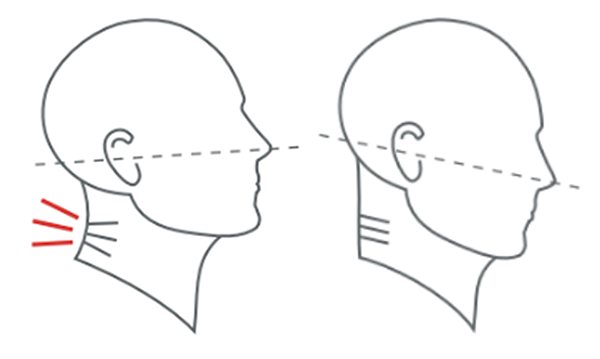
Shortened, tight muscles at the back of the neck (left) are a common cause of neck pain and tension headaches. Positioning the head and neck correctly eases this compression (right).
Remedies to avoid
Tight, short muscles may well have compressed your cervical (neck) vertebrae, and perhaps caused bone spurs or bulging discs. Be especially careful to avoid exercises which take your head into circling movements. These call for extreme flexion (forward), extension (backward) and lateral bends (side), any of which could pinch your nerves and discs. By circling through these movements in rapid succession, the risk is heightened. Performing head rotations (twists) is also commonly advocated, but if done with poor alignment, head twists can also compress tissues in the neck.
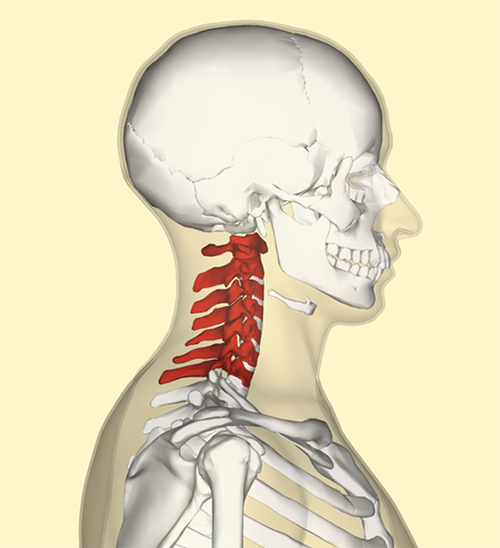
The cervical spine has seven vertebrae which support the skull. Wikipedia
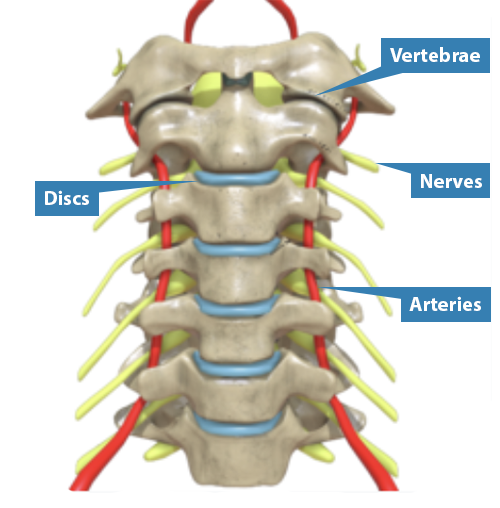
There are many delicate and vital structures within the neck, including nerves, discs, and arteries (front view). Wikipedia
The right approach
You want the principles of Primal Posture™ to guide your head back where it belongs. Appropriate support from the longus colli and other deep muscles of the neck will give the cervical spine the support it needs to align well. This will encourage your outer neck muscles to relax their grip and be gently stretched. Circulation in the area will also get a boost.
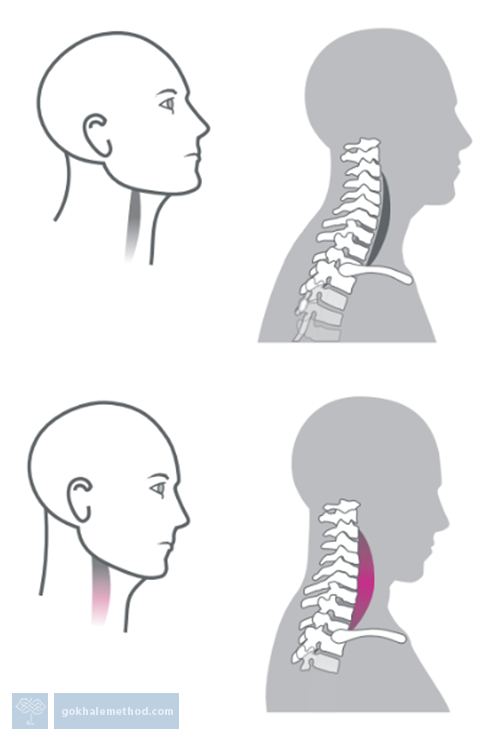
The longus colli muscles attach to the front of the cervical spine. When they contract (shown in red), they cause the neck to straighten and, therefore, lengthen.
If your neck is inflamed, it will benefit from steady, well-aligned exercise that can help to calm things down. The video clip below shows you a healthy way to lengthen tight muscles on either side of your neck. These movements do not overload your cervical discs, crunch your vertebrae, or impinge your nerves. Note that the exercise includes working at various angles to address different fibers within the same muscle.
A healthy exercise for the neck
This healthy neck stretch is from a recent 1-2-3 Move class for our Alumni.
Your checklist for this exercise is:
- Perch on the front of your chair as shown.
- Elongate your neck. Learn how to do this here.
- Reach one arm across to your opposite ear and pull upward.
- Roll open the opposite shoulder and pull that downward, leaning over sideways as you hold the rim of the chair seat. Learn how to roll your shoulders open here.
- Don’t sway. Use your rib anchor. Learn how to use your rib anchor here.
- Listen to some good music! It takes 20–30 seconds for muscles to relax.
- Stretch different muscle fibers—slowly turn your head toward your armpit.
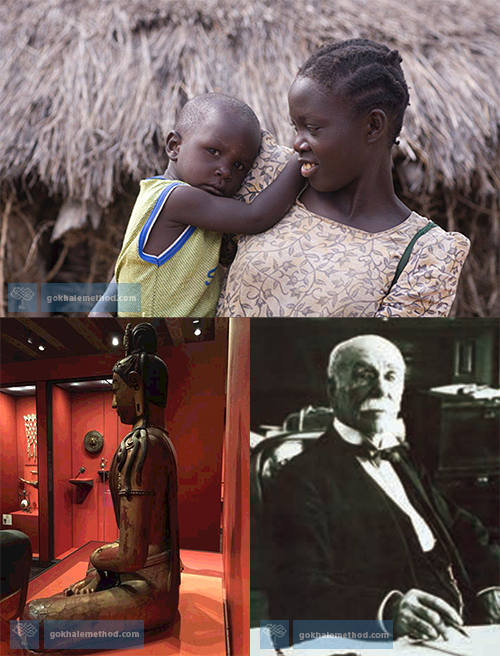
Healthy musculature allows the neck to stack in a tall, more vertical position with the head over the body, not forward.
Address the root cause of your neck pain
People usually think of their neck and any pain there as a separate issue from what is going on in their backs. From the point of view of a posture teacher, a distortion in any part of the spine will have an effect on all other parts of the spine.
For example, people sitting or standing at a computer with their heads stuck forward may try to address neck pain locally. But the root of the problem is often in the pelvis. If the pelvis is tucked (i.e., with an imaginary tail between the legs), the spine will be curved over into a C shape. You can read more about spine shape here. In this situation, any local effort to draw the neck back is going to be hard to sustain, tense, and ultimately counterproductive. But by positioning the pelvis well, the neck will have the opportunity to stack well. At this point, local work on the neck is able to provide not only symptomatic relief but can also return your cervical spine closer to its primal, healthy structure.
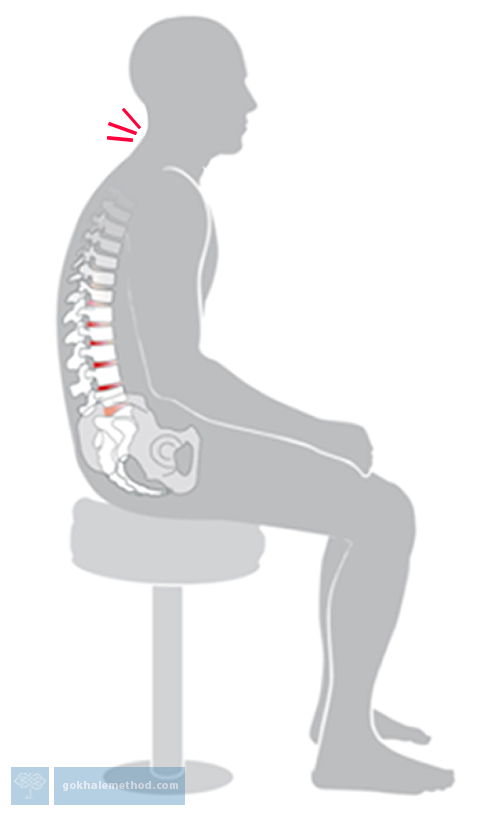
A C-shaped back stresses the lumbar (lower back) discs and is also bad news for the neck.
Join me for a special new one-hour FREE Online Workshop, Posture Remedies for Text Neck, November 12, 11 a.m. (Pacific Time), and learn helpful suggestions on how to improve the architecture and health of your neck.
If you would like an expert one-on-one assessment of your posture, including your neck alignment, you can arrange an Online Initial Consultation or take an in-person Initial Consultation if you have a Gokhale Method Teacher near you.

Comments
Add New Comment
Login to add commment
Login